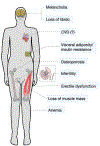Late-onset hypogonadism: Clinical evidence, biological aspects and evolutionary considerations
- PMID: 33610812
- PMCID: PMC8043243
- DOI: 10.1016/j.arr.2021.101301
Late-onset hypogonadism: Clinical evidence, biological aspects and evolutionary considerations
Abstract
The growing life expectancy in modern societies has raised scientific interest in identifying medical interventions to alleviate age-associated pathologies such as vascular calcification, cognitive decline, sarcopenia, osteoporosis and sexual dysfunction. Although no such single treatment has thus far been established in humans, some clinicians and patients have set their hopes on testosterone replacement therapy (TRT) as a potential "fountain of youth" for aging men. While TRT has proven effective in ameliorating distinct symptoms of late-onset hypogonadism (LOH), its safety remains to be demonstrated. Besides humans, multiple other species exhibit age-related reductions in circulating testosterone levels, raising the question whether such changes are an inherent, pathological feature of growing organismal age or rather reflect an adaptive response. In this manuscript, we apply key principles of evolutionary medicine to testosterone biology and LOH to provide a novel perspective on these two fields. Additionally, we discuss insightful data derived from the animal kingdom to illustrate the plasticity of individual testosterone trajectories across the lifespan, outline cost-benefit-considerations of TRT in LOH and highlight potential caveats of such therapies.
Keywords: Endocrinology; Evolution; Hormones; Late-onset hypogonadism; TRT; Testosterone.
Copyright © 2021 Elsevier B.V. All rights reserved.
Conflict of interest statement
Conflicts of interest
The authors have received honoraria, unrestricted educational grants and research funding to the individual or the institution from Alexion (LCH), Amgen (LCH, MR, TDR), Roche (TDR), Shire (LCH, TDR) and UCB (LCH, TDR). The remaining authors have no potential conflicts of interest to declare.
Figures



Similar articles
-
EMAS position statement: Testosterone replacement therapy in the aging male.Maturitas. 2016 Feb;84:94-9. doi: 10.1016/j.maturitas.2015.11.003. Epub 2015 Nov 10. Maturitas. 2016. PMID: 26614257 Review.
-
Comprehensive evaluation of androgen replacement therapy in aging Japanese men with late-onset hypogonadism.Aging Male. 2014 Jun;17(2):72-5. doi: 10.3109/13685538.2014.888052. Epub 2014 Feb 17. Aging Male. 2014. PMID: 24533913
-
Adult- and late-onset male hypogonadism: the clinical practice guidelines of the Italian Society of Andrology and Sexual Medicine (SIAMS) and the Italian Society of Endocrinology (SIE).J Endocrinol Invest. 2022 Dec;45(12):2385-2403. doi: 10.1007/s40618-022-01859-7. Epub 2022 Aug 26. J Endocrinol Invest. 2022. PMID: 36018454 Free PMC article.
-
Prospective assessment of health-related quality of life in men with late-onset hypogonadism who received testosterone replacement therapy.Andrologia. 2016 Mar;48(2):198-202. doi: 10.1111/and.12433. Epub 2015 May 18. Andrologia. 2016. PMID: 25988884
-
Controversial aspects of testosterone in the regulation of sexual function in late-onset hypogonadism.Andrology. 2020 Nov;8(6):1580-1589. doi: 10.1111/andr.12794. Epub 2020 May 8. Andrology. 2020. PMID: 32248652 Review.
Cited by
-
Filamin A cooperates with the androgen receptor in preventing skeletal muscle senescence.Cell Death Discov. 2023 Dec 2;9(1):437. doi: 10.1038/s41420-023-01737-y. Cell Death Discov. 2023. PMID: 38040692 Free PMC article.
-
The role and mechanism of quercetin in improving late-onset hypogonadism through network analysis and experimental validation.Naunyn Schmiedebergs Arch Pharmacol. 2025 Mar 17. doi: 10.1007/s00210-025-04022-0. Online ahead of print. Naunyn Schmiedebergs Arch Pharmacol. 2025. PMID: 40090989
-
Expert Consensus on Prevention and Treatment of Aging-Related Gonadal Dysfunction.Aging Dis. 2024 Apr 10;16(2):971-979. doi: 10.14336/AD.2024.0004. Aging Dis. 2024. PMID: 38739936 Free PMC article. Review.
-
Impact of Andropause on Multiple Sclerosis.Front Neurol. 2021 Nov 5;12:766308. doi: 10.3389/fneur.2021.766308. eCollection 2021. Front Neurol. 2021. PMID: 34803897 Free PMC article. Review.
-
Age-Related Hormones Changes and Its Impact on Health Status and Lifespan.Aging Dis. 2023 Jun 1;14(3):605-620. doi: 10.14336/AD.2022.1109. Aging Dis. 2023. PMID: 37191429 Free PMC article. Review.
References
-
- Stearns S. & Medzhitov R. Evolutionary Medicine. 306 (Sinauer Associates, Oxford University Press, 2016).
-
- Stearns SC, Allal N. & Mace R. Chapter 3: Life history theory and human development. 47–69 (Crawford CK(ed.), Lawrence Erlbaum Associates, New York, Foundations of Evolutionary Psychology, 2008).
-
- Feldman HA, et al. Age trends in the level of serum testosterone and other hormones in middle-aged men: longitudinal results from the Massachusetts male aging study. J Clin Endocrinol Metab 87, 589–598 (2002). - PubMed
-
- Johnson SL, Dunleavy J, Gemmell NJ & Nakagawa S. Consistent age-dependent declines in human semen quality: a systematic review and meta-analysis. Ageing Res Rev 19, 22–33 (2015). - PubMed
Publication types
MeSH terms
Substances
Grants and funding
LinkOut - more resources
Full Text Sources
Other Literature Sources
Medical

